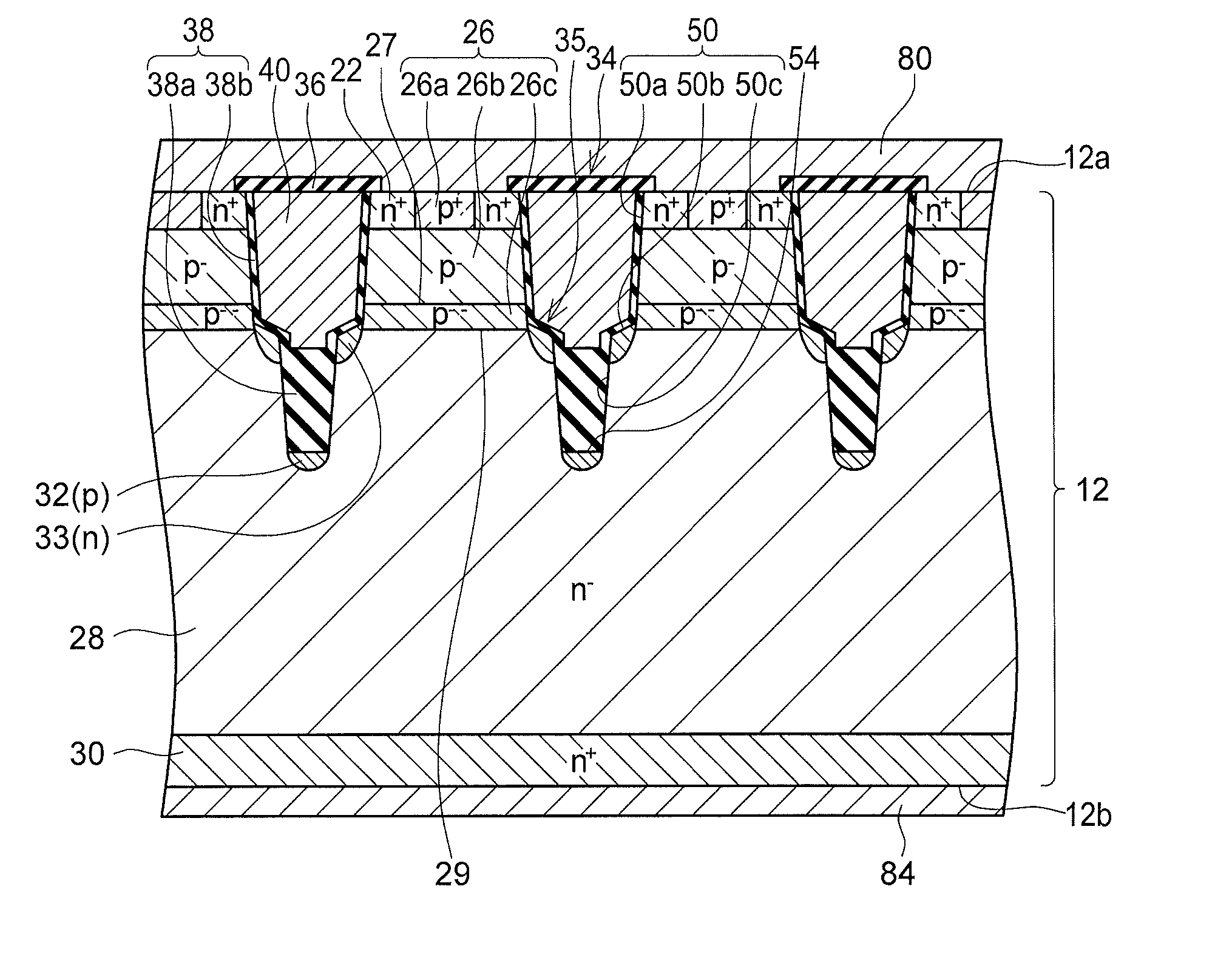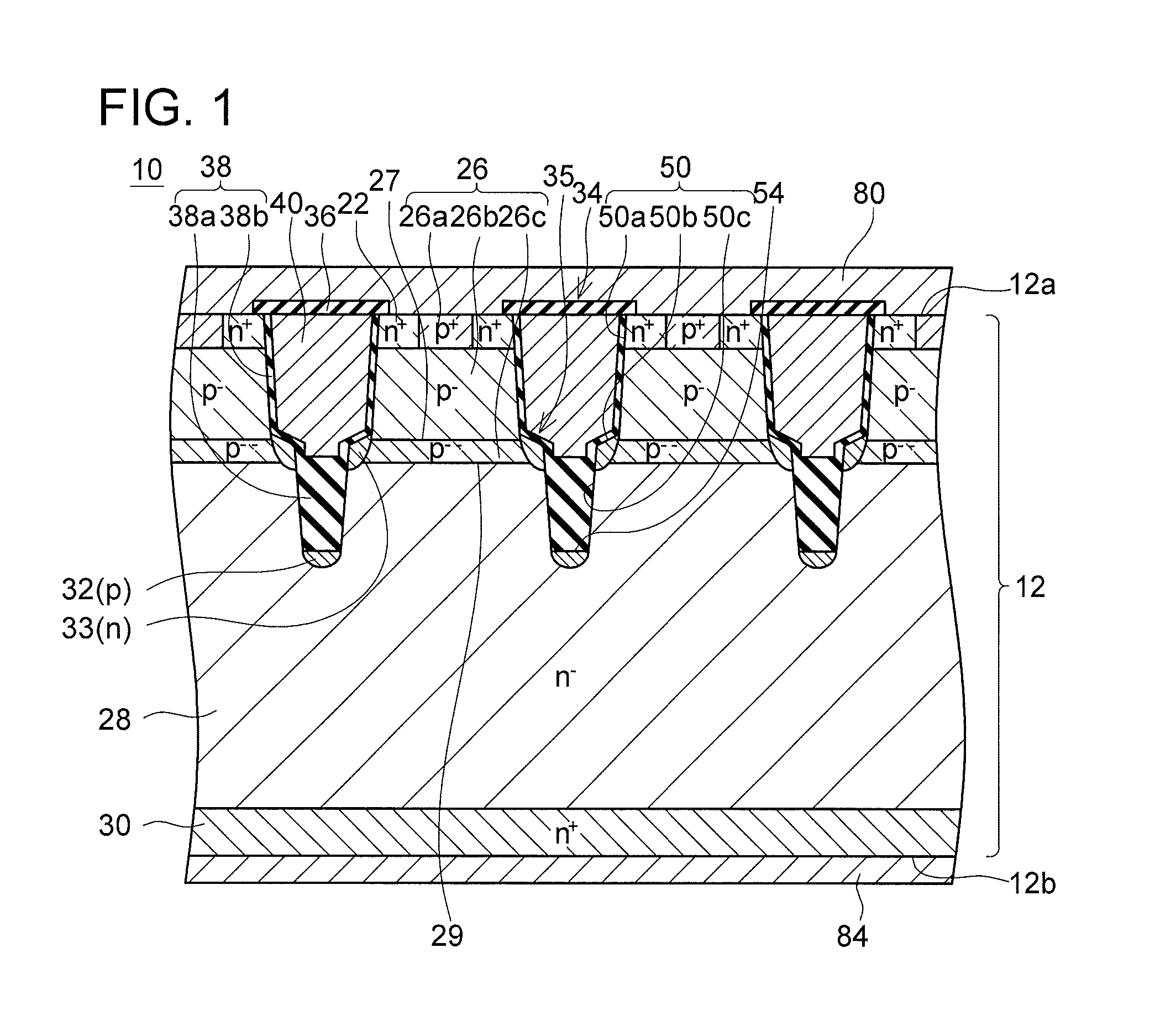Semiconductor device and method for manufacturing semiconductor device
- Summary
- Abstract
- Description
- Claims
- Application Information
AI Technical Summary
Benefits of technology
Problems solved by technology
Method used
Image
Examples
embodiment 1
[0024]As shown in FIG. 1, a semiconductor device 10 according to Embodiment 1 includes a semiconductor substrate 12 and electrodes, insulating layers, and the like located on a front surface 12a and / or a back surface 12b of the semiconductor substrate 12. The semiconductor substrate 12 is made of 4H—SiC.
[0025]A source electrode 80 is located on the front surface 12a of the semiconductor substrate 12. A drain electrode 84 is located on the back surface 12b of the semiconductor substrate 12. The drain electrode 84 covers substantially a whole area of the back surface 12b.
[0026]Each trench 34 has a side surface 50. A step 35 is formed in the side surface 50 of the each trench 34. The side surface 50 of the each trench 34 includes an upper side surface 50a located on an upper side with respect to the step 35, a step surface 50b which is a surface of the step 35, and a lower side surface 50c located on a lower side with respect to the step 35. The step surface 50b of the step 35 slopes ...
embodiment 2
[0050]As shown in FIG. 9, a semiconductor device according to Embodiment 2 has steps 35 located at a level lower than a level of the boundary 27 between the upper region 26b and the lower region 26c. The steps 35 are located on an upper side with respect to the p-n junction 29 at a boundary between the lower region 26c and the drift region 28. The other components of the semiconductor device of Embodiment 2 are identical to those of the semiconductor device 10 of Embodiment 1. Also in the semiconductor device according to Embodiment 2, the side regions 33 protrude toward an upper side with respect to the drift region 28. This makes it possible to achieve compatibility between the channel length and the punch-through voltage. Further, by taking a longer etching time to form the trenches 34 than in Embodiment 1, the steps 35 can be located at the level lower than the level of the boundary 27 between the upper region 26b and the lower region 26c as in Embodiment 2.
embodiment 3
[0051]As shown in FIG. 10, a semiconductor device according to Embodiment 3 has steps 35 that do not slope. That is, the steps 35 are formed substantially parallel to the surface 12a of the semiconductor substrate 12. Further, in the semiconductor device according to Embodiment 3, the body region 26, on a lower side with respect to the high-concentration region 26a, includes only a low-concentration region 26d. That is, whereas the body region 26 includes the upper region 26b and the lower region 26c on the lower side with respect to the high-concentration region 26a in Embodiment 1, a p-type impurity concentration in a portion (i.e. the low-concentration region 26d) of the body region 26 that is located on the lower side with respect to the high-concentration region 26a is substantially uniform. The p-type impurity concentration of the low-concentration region 26d is lower than that of the high-concentration region 26a. Also in the semiconductor device according to Embodiment 3, th...
PUM
 Login to View More
Login to View More Abstract
Description
Claims
Application Information
 Login to View More
Login to View More - R&D
- Intellectual Property
- Life Sciences
- Materials
- Tech Scout
- Unparalleled Data Quality
- Higher Quality Content
- 60% Fewer Hallucinations
Browse by: Latest US Patents, China's latest patents, Technical Efficacy Thesaurus, Application Domain, Technology Topic, Popular Technical Reports.
© 2025 PatSnap. All rights reserved.Legal|Privacy policy|Modern Slavery Act Transparency Statement|Sitemap|About US| Contact US: help@patsnap.com



